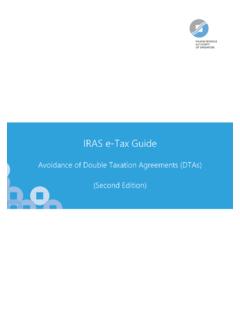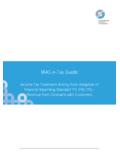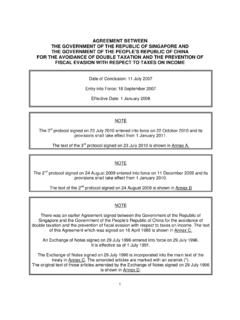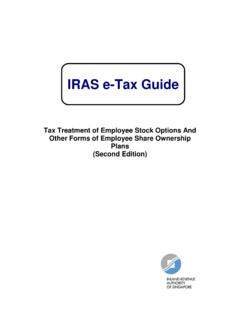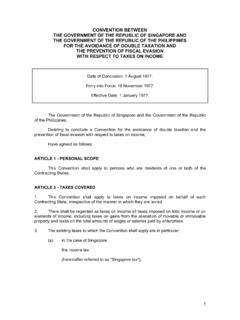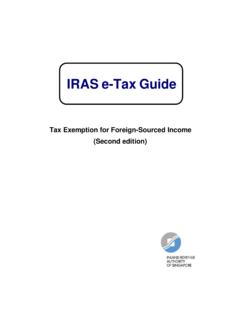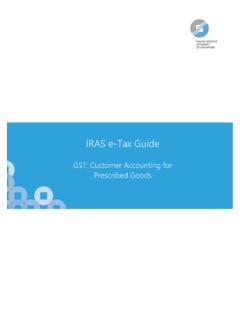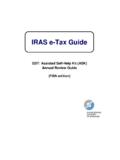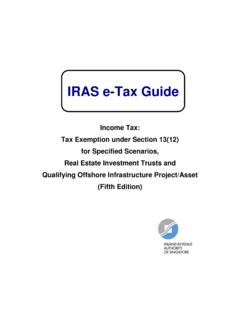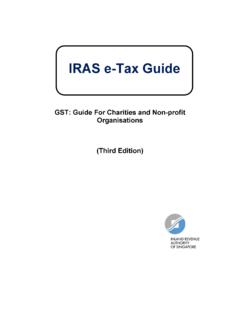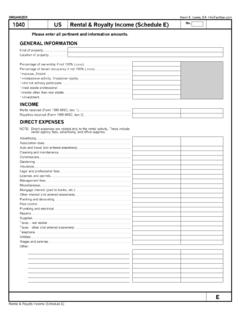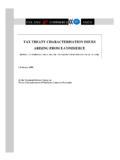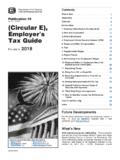Transcription of IRAS e-Tax Guide
1 Productivity and Innovation Credit (Fifth Edition) IRAS e-Tax Guide Published by Inland Revenue Authority of Singapore Published on 22 Nov 2016 Fourth edition on 19 Sep 2014 Third edition on 20 Sep 2013 Second edition on 17 Aug 2012 First edition on 15 Jul 2011 Disclaimers: IRAS shall not be responsible or held accountable in any way for any damage, loss or expense whatsoever, arising directly or indirectly from any inaccuracy or incompleteness in the Contents of this e-Tax Guide , or errors or omissions in the transmission of the Contents.
2 IRAS shall not be responsible or held accountable in any way for any decision made or action taken by you or any third party in reliance upon the Contents in this e-Tax Guide . This information aims to provide a better general understanding of taxpayers tax obligations and is not intended to comprehensively address all possible tax issues that may arise. While every effort has been made to ensure that this information is consistent with existing law and practice, should there be any changes, IRAS reserves the right to vary our position accordingly. Inland Revenue Authority of Singapore All rights reserved.
3 No part of this publication may be reproduced or transmitted in any form or by any means, including photocopying and recording without the written permission of the copyright holder, application for which should be addressed to the publisher. Such written permission must also be obtained before any part of this publication is stored in a retrieval system of any nature. i Table of Contents Productivity and Innovation Credit .. 1 1. Aim .. 1 2. Background .. 1 3. Overview of PIC, PIC Bonus and PIC+ .. 1 4. General Framework .. 3 5. Administrative Procedures .. 11 6. Enquiries .. 12 7. Updates and Amendments.
4 13 Annex A .. 16 Enhanced Capital Allowance and Deduction for Qualifying Equipment .. 16 1. Introduction .. 16 2. Qualifying Equipment .. 16 3. Computation of Capital Allowance under PIC Acquisition of Qualifying 18 4. Option to Convert Qualifying Expenditure into Cash Acquisition of Qualifying Equipment .. 20 5. Minimum Ownership Period of Qualifying Equipment .. 22 6. Others .. 25 7. Computation of Deduction under PIC Leasing of Qualifying Equipment .. 25 8. Option to Convert Qualifying Expenditure into Cash Leasing of Qualifying Equipment .. 27 9. Cloud Computing .. 27 Annex A-1: Example illustrating the conversion of qualifying expenditure into cash and the computation of capital 29 Annex A-2: Examples illustrating the application of the claw-back provisions.
5 31 Annex B .. 35 ii Enhanced Writing-Down Allowance ( WDA ) and Deduction for Intellectual Property Rights ( IPRs ) .. 35 1. Introduction .. 35 2. Definition of IPR .. 35 3. Computation of WDA under PIC Acquisition of IPRs .. 36 4. Option to Convert Qualifying Expenditure into Cash Acquisition of IPRs .. 36 5. Minimum Ownership Period of IPR .. 37 6. IPRs Approved for Investment Allowance .. 39 7. IPRs in Respect of Software .. 39 8. Computation of Deduction under PIC Licensing of IPRs .. 40 9. Option to Convert Qualifying Expenditure into Cash Licensing of IPRs .. 42 Annex B-1: Examples illustrating the application of the claw-back provisions.
6 43 Annex C .. 47 Enhanced Tax Deduction of Costs for Registering Patents, Trademarks, Designs and Plant Varieties .. 47 1. Introduction .. 47 2. Registration Costs .. 47 3. Computation of Enhanced Deduction under PIC .. 48 4. Option to Convert Registration Costs into Cash .. 48 5. Minimum Ownership Period .. 48 Annex D .. 50 Enhanced Tax Deduction of Qualifying Research & Development ( R&D ) Expenditure .. 50 1. Introduction .. 50 2. Computation of Enhanced Deduction under PIC .. 50 3. Option to Convert Qualifying R&D Expenditure into Cash .. 53 4. Cap on Amount of Deductions under Sections 14, 14D, 14DA and 14E of the ITA.
7 54 iii Annex E .. 55 Enhanced Tax Deduction of Qualifying Training Expenditure .. 55 1. Introduction .. 55 2. Training of employees and prescribed classes of individuals .. 55 3. Qualifying Training Expenditure: In-house Training .. 56 4. Qualifying Training Expenditure: External Training .. 58 5. Option to Convert Qualifying Training Expenditure into Cash .. 58 Annex F .. 59 Enhanced Tax Deduction of Qualifying Design Expenditure .. 59 1. Introduction .. 59 2. General Framework .. 59 3. Option to Convert Qualifying Design Expenditure into Cash .. 60 Annex G .. 61 Productivity and Innovation Credit Plus Scheme ( PIC+ ) .. 61 1.
8 Introduction .. 61 2. Combined Expenditure Cap .. 61 3. Qualifying Conditions .. 62 4. Reference Point for Determining Eligibility .. 63 5. Option to Convert Qualifying Expenditure into Cash .. 64 Annex H .. 66 Examples of Abusive PIC Arrangements .. 66 1 Productivity and Innovation Credit 1. Aim This e-Tax Guide1 explains the Productivity and Innovation Credit scheme ( PIC ). This e-Tax Guide is relevant to businesses that wish to claim PIC benefits. 2. Background PIC was introduced in Budget 2010 for Year of Assessment ( YA ) 2011 to YA 2015 to encourage productivity and innovation activities in Singapore.
9 The scheme was further extended for three years till YA 2018 in Budget 2014. In Budget 2013, an additional cash bonus (known as PIC bonus) was announced as part of a 3-year transition support package under the Quality Growth Programme. Besides encouraging investments in productivity and innovation, PIC bonus seeks to defray rising operating costs faced by businesses. The PIC bonus has lapsed after YA2015. In Budget 2014, a PIC+ scheme was introduced to provide support to small and medium enterprises ( SMEs ) that are making more substantial investments to transform their businesses.
10 The PIC scheme has benefited many businesses since its introduction and has been instrumental in kick-starting the productivity drive. As announced in Budget 2016, the PIC scheme will lapse after YA 2018. In addition, the cash payout rate has been reduced from 60% to 40% for qualifying expenditure incurred on or after 1 Aug 2016. These changes are in line with the Industry Transformation Programme to direct the Government's assistance towards more targeted and sectoral-focused initiatives. 3. Overview of PIC, PIC Bonus and PIC+ PIC PIC is available for YA 2011 to YA 2018 ( qualifying YAs ).
